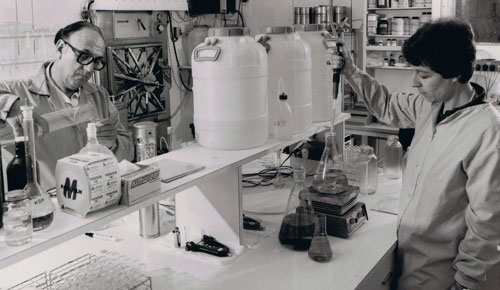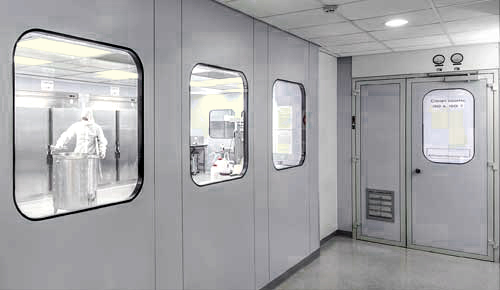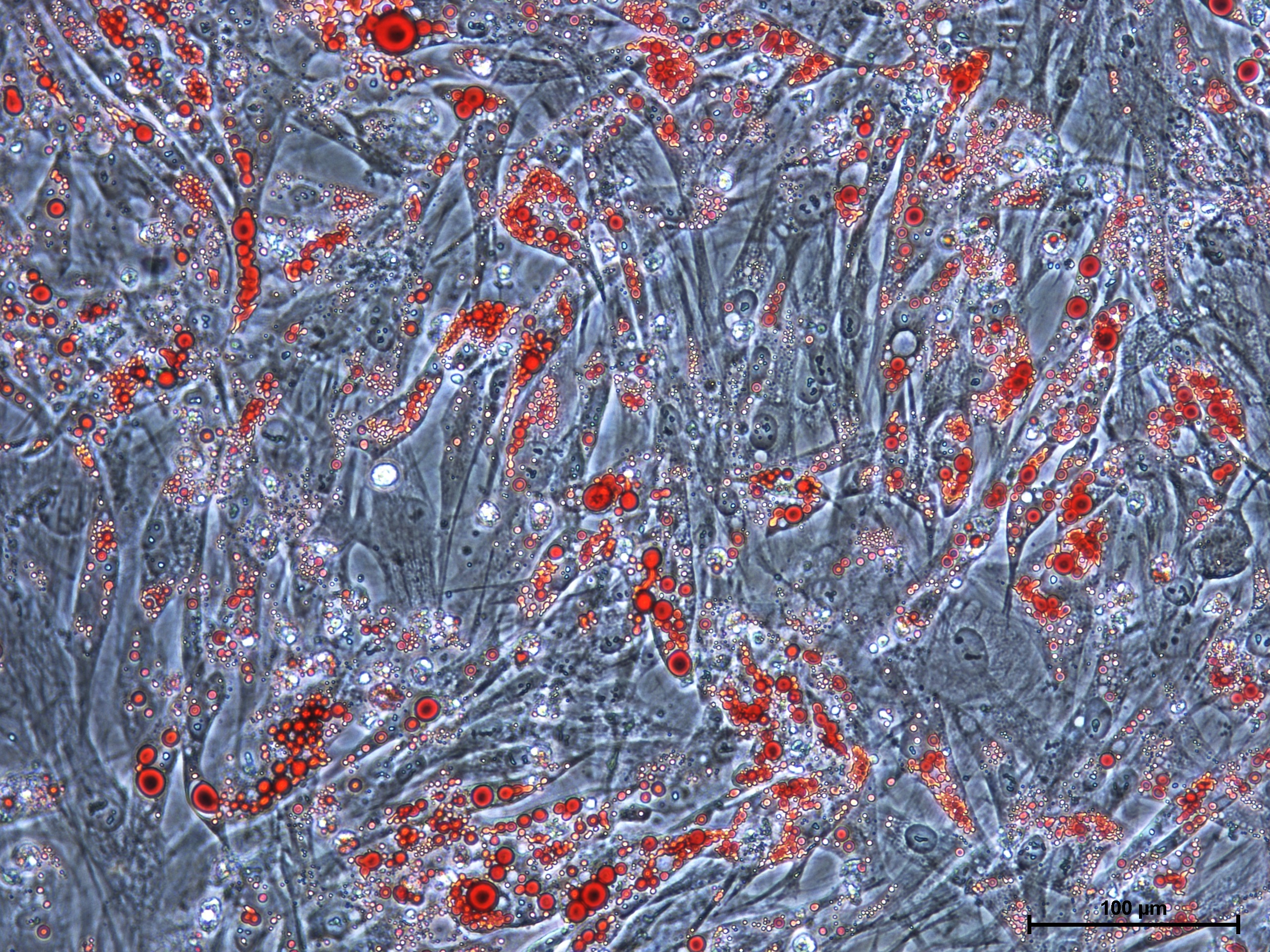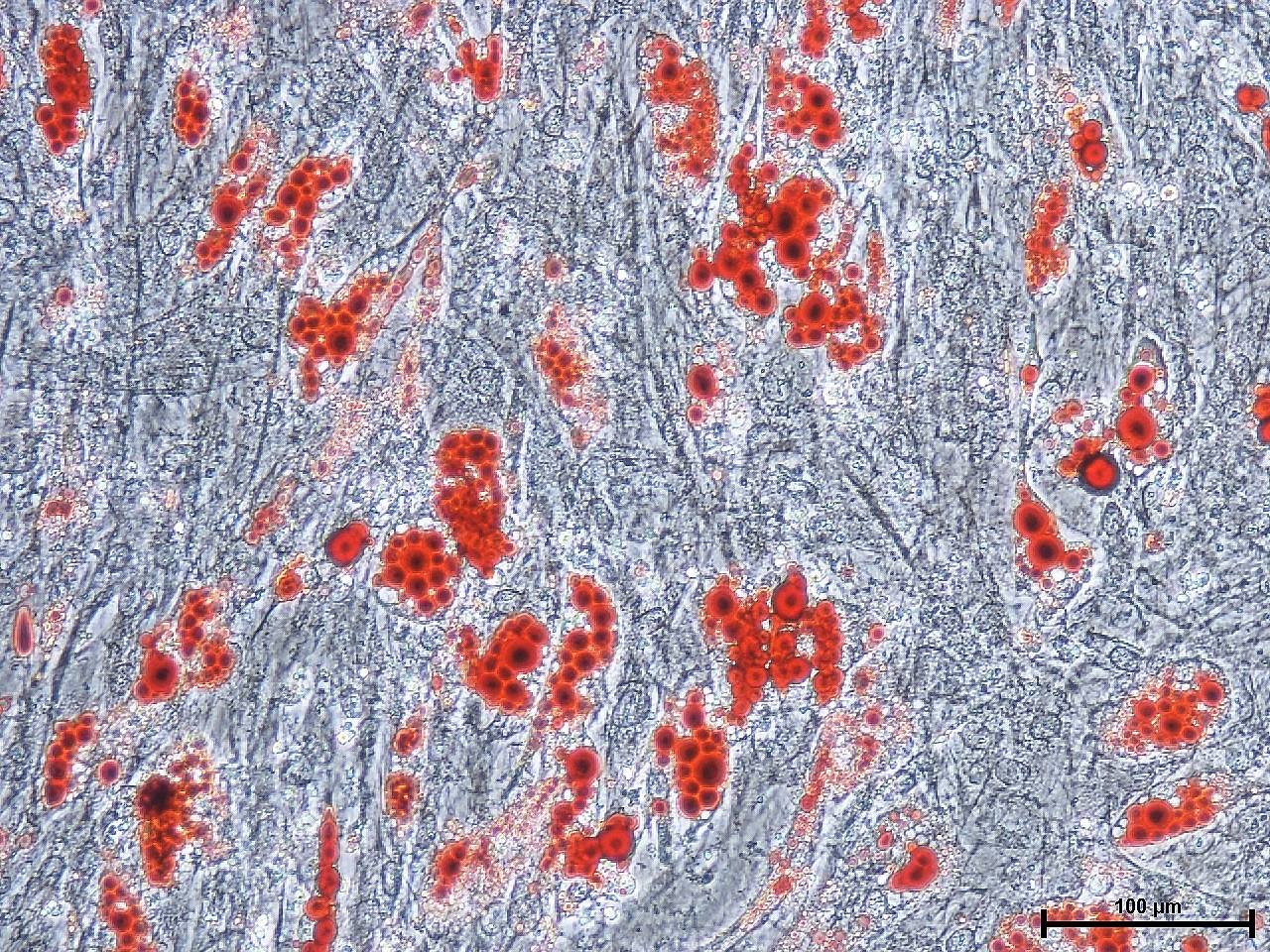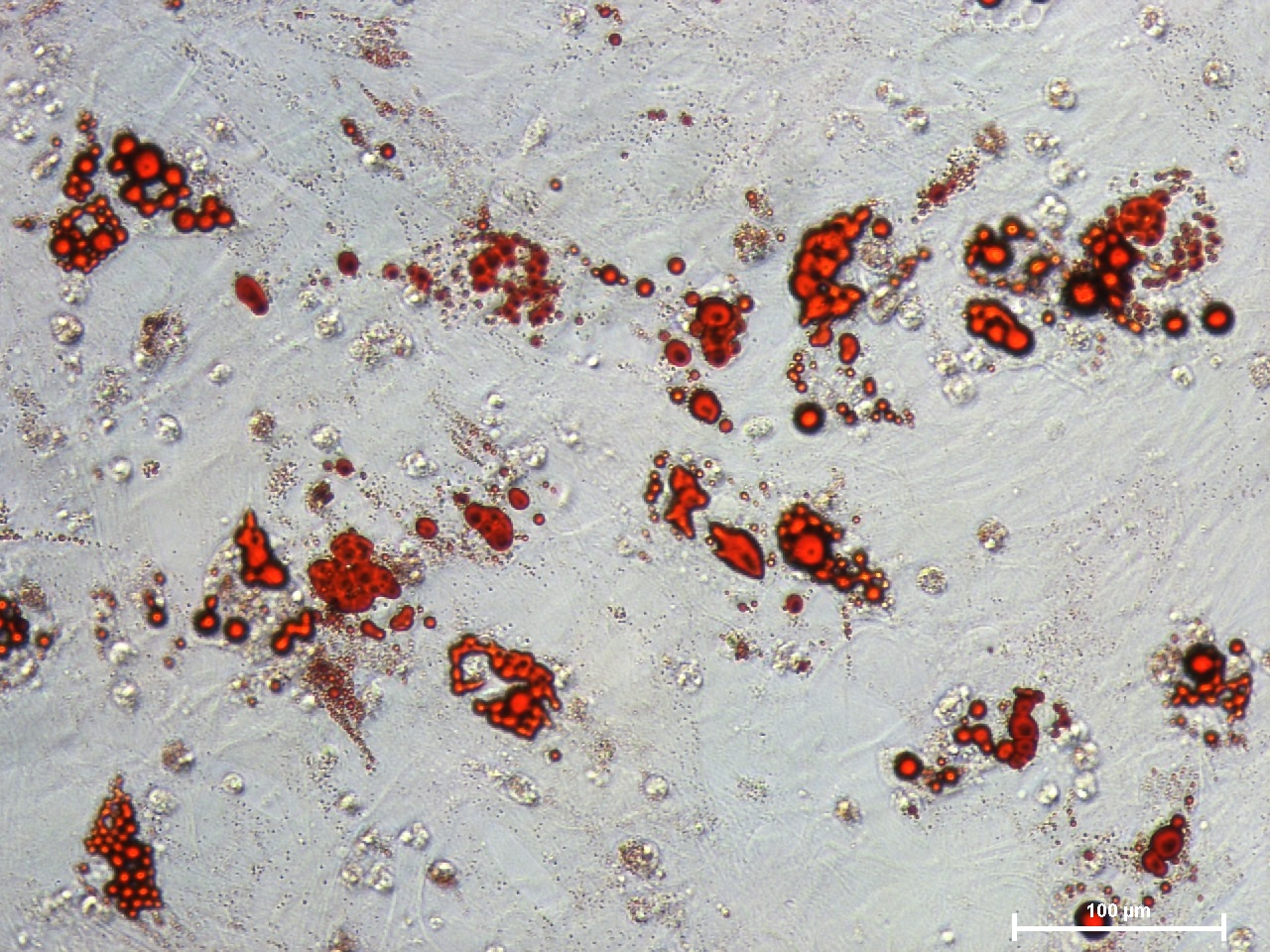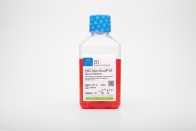Description
Details
Product Overview
MSCgo™ Adipogenic Differentiation Medium is a serum-free and xeno-free formulation developed for optimal differentiation of human mesenchymal stem cells (hMSC) to mature adipocytes. The MSCgo™ Adipogenic Differentiation Medium is validated to efficiently differentiate hMSC from a variety of sources, including bone marrow (BM-MSC), adipose tissue (AT-MSC), umbilical cord tissue (UC-MSC), and Wharton’s jelly (WJ-MSC). The MSCgo™ Adipogenic Differentiation Medium kit includes a basal medium and two supplement mixes, containing all growth factors and supplements necessary for a complete adipoogenic differentiation medium. No additional supplements are required.
The MSCgo™ Adipogenic Differentiation protocol is part of a complete system for multipotency evaluation of hMSCs. This kit enables reliable differentiation of hMSCs to mature adipocytes without background differentiation or interruption in cellular metabolism.
Features
- Serum-free, xeno-free medium
- All required growth factors and supplements included in kit
- Reliable differentiation to mature adipocytes
- Each lot is application tested
- Contains stable L-alanyl-L-glutamine
- Does not contain antibiotics
Components
- MSCgo Adipogenic Differentiation Basal Medium: 100 mL
- MSCgo Adipogenic Differentiation Supplement Mix I: 100 μL
- MSCgo Adipogenic Differentiation Supplement Mix II: 1.5 mL
Adipogenesis Results
Adipogenic differentiation of hMSC results in the formation of spherical cells accumulated with lipid droplets that can be detected using an inverted microscope. The amount of differentiated cells can be vary using different hMSC (e.g. source, age, and passage number).
After expansion in culture using MSC NitriStem XF Medium, hMSCs from adipose tissue (hMSC-AT), bone marrow (hMSC-BM), and cord tissue (hMSC-CT) were transfered to a differentiation assay in MSCgo™ Adipogenic Differentiation Medium. Images were taken after 16 days of adipogenesis and Oil Red-O staining (20x).
Specifications
Specifications
| Form | Liquid |
|---|---|
| Brand | MSCgo™ |
| Storage Conditions | Adipogenic Differentiation Basal Medium: 2 to 8°C Adipogenic Differentiation Supplement Mix I: -20°C Adipogenic Differentiation Supplement Mix II: -20°C |
| Quality Control | The MSCgo Adipogenic Differentiation Medium is validated for optimal differentiation of hMSC into chondrocytes. Additional tests are: pH, osmolality, endotoxins and sterility tests. |
| Specifications | Required Materials for Adipogenic Assay:
|
| Instructions for Use | Complete Medium Preparation
Note: The combination of both MSCgo Adipogenic Supplement Mix I and II into the Basal Medium generates a complete medium that is ready for use. No additional supplements are required. |
| Legal | For human ex vivo tissue and cell culture processing applications. This reagent is not approved for human or animal use, or for application of in vitro diagnostic procedures. |
References
references
- C. Zheng et al. miR-92a-3p-inspired shRNA exhibits pro-chondrogenic and chondrocyte protective effects in osteoarthritis treatment through targeting SMAD6/7. Journal of Bone and Mineral Metabolism, 2023
- W. Zhou et al. Autophagy inhibition restores CD200 expression under IL-1β microenvironment in placental mesenchymal stem cells of fetal origin and improves its pulmonary fibrosis therapeutic potential. Molecular Immunology, Volume 151, November 2022
- V.P. Mantripragada and G.F. Muschler Improved biological performance of human cartilage-derived progenitors in platelet lysate xenofree media in comparison to fetal bovine serum media. Current Research in Translational Medicine, 2022
- S. Cai et al. Single-cell RNA sequencing reveals the potential mechanism of heterogeneity of immunomodulatory properties of foreskin and umbilical cord mesenchymal stromal cells. Cell & Bioscience volume 12, Article number: 115 (2022)
- X. Kang et al. . Zuogui Wan slowed senescence of bone marrow mesenchymal stem cells by suppressing Wnt/β-catenin signaling. Journal of Ethnopharmacology, 2022
- X. Zhang, et al. Human umbilical cord mesenchymal stem cell-derived exosomal microRNA-148a-3p inhibits neointimal hyperplasia by targeting Serpine1. Archives of Biochemistry and Biophysics, Volume 719, 2022
- Y. Xiong, et. al, Effects of different methods of demineralized dentin matrix preservation on the proliferation and differentiation of human periodontal ligament stem cells. Journal of Dental Sciences, 2022, https://doi.org/10.1016/j.jds.2022.01.007.
- E. Atanasova, et al. Normal ex vivo mesenchymal stem cell function combined with abnormal immune profiles sets the stage for informative cell therapy trials in idiopathic pulmonary fibrosis patients. Stem Cell Res Ther, 2022. https://doi.org/10.1186/s13287-021-02692-0
- V.A. Nikitina, et al. Cytogenetic Characteristics of Diploid Lines of Mesenchymal Multipotent Stromal Cells. Cell Tiss. Biol. 15, 604–615 (2021). https://doi.org/10.1134/S1990519X21060146
- J. Wang, et al. Trehalose glycopolymers for cryopreservation of tissue-engineered constructs. Cryobiology, 2021, https://doi.org/10.1016/j.cryobiol.2021.11.004.
- C. Siyu, et al. Single Cell Transcriptome Sequencing Reveals the Potential Mechanism of Heterogeneity in Immunoregulatory Function Between Mesenchymal Stromal Cells. research square,2021, DOI: https://doi.org/10.21203/rs.3.rs-823639/v1
- E. Atanasova, et al. Autologous Mesenchymal Stem Cell Therapy for Idiopathic Pulmonary Fibrosis and Comprehensive Assessment of Circulating Immune Populations Cells. Mayo Clinic College of Medicine. 2021 https://doi.org/10.21203/rs.3.rs-570630/v1
- Y. Matsuo, et al. Isolation of adipose tissue-derived stem cells by direct membrane migration and expansion for clinical application. Human Cell (2021). https://doi.org/10.1007/s13577-021-00505-3
- S. Kikuchi, et al. Development of a nasal mucosa-removal model for evaluating cell therapy. Regenerative Therapy, Volume 16, 2021, P. 32-41, ISSN 2352-3204, https://doi.org/10.1016/j.reth.2020.12.004.
- J. Min, et al. Phenotype and biological characteristics of endometrial mesenchymal stem / stromal cells:A comparison between intrauterine adhesion patients and healthy women. AJRI, 18 November 2020, https://doi.org/10.1111/aji.13379
- L. Xie et al., Alteration of circRNA and lncRNA expression profile in exosomes derived from periodontal ligament stem cells undergoing osteogenic differentiation. Archives of Oral Biology, 2020, 104984, https://doi.org/10.1016 /j.archoralbio.2020.104984.
- G. Çiçek, et al. Examination of Adipose Tissue-derived Mesenchymal Stem Cell Surface Markers in a Hypoxic Environment. Cell Tiss. Biol. 14, 325–331 (2020). https://doi.org/10.1134/S1990519X20050028
- E. Çerçi & H. Erdost, Rapid, practical and safe isolation of adipose derived stem cells. Biotechnic & Histochemistry, 23 Jun 2020. DOI:10.1080/10520295.2020.1776895
- R. Moloudi et al. Inertial-Based Filtration Method for Removal of Microcarriers from Mesenchymal Stem Cell Suspensions. Scientific Reportsvolume 8, Article number: 12481 (2018)
- A. Mamchur et al. Adipose‐Derived Stem Cells of Blind Mole Rat Spalax Exhibit Reduced Homing Ability: Molecular Mechanisms and Potential Role in Cancer Suppression. Stem Cells, Volume36, Issue10, October 2018, Pages 1630-1642
- L. Sun et al. Human gastric cancer mesenchymal stem cell-derived IL15 contributes to tumor cell EMT via up-regulation of Tregs ratio and PD-1 expression in CD4+T cell. Stem Cells and Development, 2018
- J. Leber et al., Microcarrier choice and bead-to-bead transfer for human mesenchymal stem cells in serum-containing and chemically defined media. Process Biochemistry, volume 59, Part B, August 2017, Pages 255-265
- L. Pu et al., Compared to the amniotic membrane, Wharton’s jelly may be a more suitable source of mesenchymal stem cells for cardiovascular tissue engineering and clinical regeneration. Stem Cell Research & Therapy 2017 8:72
- M. Meng et al., Umbilical cord mesenchymal stem cell transplantation in the treatment of multiple sclerosis. American Journal of Translational Research, 2018;10(1):212-223
Documentation
Materials Safety Data Sheet
 MSCgo™ Adipogenic Differentiation Medium (MSDS)
MSCgo™ Adipogenic Differentiation Medium (MSDS) MSCgo™ Adipogenic Differentiation Supplement Mix I (MSDS)
MSCgo™ Adipogenic Differentiation Supplement Mix I (MSDS) MSCgo™ Adipogenic Differentiation Supplement Mix II (MSDS)
MSCgo™ Adipogenic Differentiation Supplement Mix II (MSDS)
Manuals and Protocols
Product Literature
Certificate of Analysis
COA's can be downloaded from Sartorius's Certificates Portal.
For certificates issued before November 15, 2021, please enter below the product lot number and click search.

